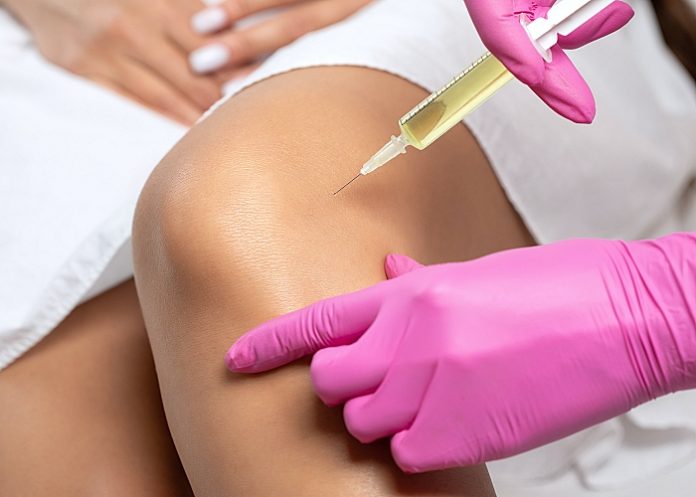A pilot study conducted by researchers at Baylor College of Medicine showed that a single injection of platelet-rich-plasma (PRP) in the knee joint significantly improved functional mobility, pain and quality of life after six weeks in osteoarthritis (OA).
The results, published in the journal Regenerative Medicine, supports using this combined approach to further evaluate this and other emerging biological therapies for musculoskeletal disorders in larger clinical trials.
"OA is a leading cause of disabilities, affecting nearly 52 million Americans," said first and corresponding author Dr Prathap Jayaram, director of regenerative sports medicine and assistant professor in the Department of Physical Medicine and Rehabilitation and Orthopaedic Surgery at Baylor. "It has been estimated that more than 80% of people over 55 have some X-ray-based evidence of the disease."
OA develops when the smooth cushion between bones, the cartilage, breaks down. Progressively, joints become painful, swollen and hard to move, Jayaram explained. Currently, there are no validated therapies that delay disease progression. The current standard of care is limited to the alleviation of symptoms with corticosteroids.
"However, although steroids seem to be helpful in the short term for pain, emerging evidence has associated steroid long-term use in OA with loss of cartilage," Jayaram said. "As OA is a whole joint disease, there is a need for developing novel therapeutic strategies that ultimately prevent and/or delay disease progression while improving functional outcomes. PRP is emerging as one of the promising candidates to treat OA that are currently being used in clinical practice."
Combining wearable technology and patient assessment to evaluate the treatment
One challenge of previous studies assessing PRP therapies in OA is that treatment evaluation is based on patient-reported outcomes that subjectively assess pain or aspects of joint function, such as the time up-and-go (TUG), how quickly a person gets up from a chair.
In this study, Jayaram and colleagues incorporated wearable technology to objectively assess functional outcomes such as TUG, in addition to patient-reported outcomes to comprehensively evaluate the efficacy of PRP in knee OA (KOA).
The prospective pilot study included 12 patients diagnosed with KOA. Each patient received one ultrasound-guided injection of PRP and function and pain were evaluated six weeks later.
PRP is prepared from the patient's own blood by removing the red blood cells and enriching the concentration of platelets. PRP also contains white blood cells, or leukocytes. PRPs are formulated either leucocyte-rich (LR) or leukocyte-poor. A preclinical study by Jayaram and his colleagues had previously shown that LR-PRP had potential disease-modifying effects that correlated with functional outcomes.
"In the current study, we found that a single injection of LR-PRP into the knee does significantly improve functional mobility, pain and quality of life at six weeks," Jayaram said. "To our knowledge, our study is the first to report the efficacy of LR-PRP on objective functional outcomes using wearable sensor technology and validated patient-reported outcomes. Our findings provide the basis to conduct larger randomised clinical trials of PRP."
Study details
Novel assessment of leukocyte-rich platelet rich plasma on functional and patient reported outcomes in knee osteoarthritis: a pilot study.
Prathap Jayaram, Gu Eon Kang, Brett L Heldt, Olumide Sokunbi, Bo Song, Peter C Yeh, Max Epstein, Theodore B Shybut, Brendan H Lee, Bijan Najafi.
Published in Regenerative Medicine on 23 August 2021
Abstract
Background
Leukocyte-rich platelet-rich plasma (LR-PRP) has demonstrated to be beneficial for patients with knee osteoarthritis (KOA); however, reliable objective end points to accurately assess its therapeutic effects is lacking.
Aim
To investigate the efficacy of LR-PRP as assessed by functional and patient-reported outcomes at early time points (6 weeks).
Materials & methods
We conducted a prospective cohort study in 12 patients with diagnosed KOA (Kellgren Lawrence score of II–III), who underwent a single ultrasound-guided LR-PRP injection.
Results
There was significant improvement in timed up and go, pain and quality of life scales and balance parameters. There were nonsignificant improvements in range of motion and gait parameters.
Conclusion
LR-PRP demonstrates efficacy in meaningful end points for functional and patient-reported outcomes at early time points in patients with KOA.
See more from MedicalBrief archives:
Why knee joint injury leads to osteoarthritis
New evidence that hip and knee steroid injections more dangerous than thought
Benefit of knee surgery ‘inconsequential’
Supplementation not supported in knee osteoarthritis

